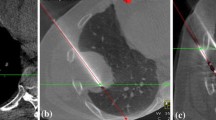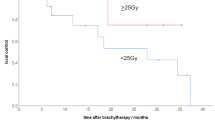Background and Purpose:
CT-guided interstitial brachytherapy of primary lung malignancies and pulmonary metastases represents a novel interventional technique, combining conventional high-dose-rate (HDR) iridium-192 (192Ir) brachytherapy with modern CT guidance for applicator positioning and computer-aided 3-D radiation treatment planning. The purpose of this study was to assess safety and efficacy of this technique.
Patients and Methods:
30 patients with 83 primary or secondary lung malignancies were recruited in a prospective nonrandomized trial (Table 1). After catheter positioning under CT fluoroscopy, a spiral CT was acquired for treatment planning (Figure 1). All but two patients received a defined single dose (coverage > 99%) of at least 20 Gy from a 192Ir source in HDR technique.
Results:
Adverse effects were nausea (n = 3, 6%), minor (n = 6, 12%) and one major pneumothorax (2%). Post intervention, no changes of vital capacity and forced expiratory volume could be detected. The median follow-up period was 9 months (1–21 months) with a local tumor control of 91% at 12 months (Figure 2).
Conclusion:
CT-guided interstitial brachytherapy proved to be safe and effective for the treatment of primary and secondary lung malignancies.
Hintergrund und Ziel:
Die CT-gesteuerte interstitielle Brachytherapie von primären Lungenmalignomen und Lungenmetastasen stellt eine weiterentwickelte interventionelle Technik dar, welche die konventionelle Hochdosisraten-(HDR)-Iridium-192-(192Ir-)Brachytherapie mittels moderner CT-Bildführung zur Applikatorpositionierung und computergestützter 3-D-Bestrahlungsplanung kombiniert. Ziel der Studie war die Analyse von Sicherheit und Effektivität dieses Verfahrens.
Patienten und Methodik:
30 Patienten mit 83 primären Lungenmalignomen oder pulmonalen Metastasen wurden in einer prospektiven, nicht randomisierten Phase-II-Studie behandelt (Tabelle 1). Nach Katheterpositionierung unter CT-Fluoroskopie erfolgte die Gewinnung eines 3-D-Datensatzes für die Bestrahlungsplanung (Abbildung 1). Alle Patienten bis auf zwei erhielten eine vorgeschriebene Einzeldosis (Abdeckung > 99%) von mindestens 20 Gy über eine 192Ir-Quelle in HDR-Technik.
Ergebnisse:
Minorkomplikationen waren Übelkeit (n = 3, 6%), diskreter (n = 6, 12%) sowie ein therapiebedürftiger Pneumothorax (2%). Postinterventionell ergaben sich keine Änderungen der Vitalkapazität oder des forcierten exspiratorischen Volumens. Die mediane Nachbeobachtungszeit betrug 9 Monate (1–21 Monate). Die lokale Tumorkontrolle lag nach 12 Monaten bei 91% (Abbildung 2).
Schlussfolgerung:
Die CT-gesteuerte interstitielle HDR-Brachytherapie stellt ein sicheres und effektives Verfahren zur Behandlung von primären Lungenmalignomen und pulmonalen Metastasen dar.
Similar content being viewed by others
Author information
Authors and Affiliations
Corresponding author
Rights and permissions
About this article
Cite this article
Peters, N., Wieners, G., Pech, M. et al. CT-Guided Interstitial Brachytherapy of Primary and Secondary Lung Malignancies. Strahlenther Onkol 184, 296–301 (2008). https://doi.org/10.1007/s00066-008-1718-5
Received:
Accepted:
Issue Date:
DOI: https://doi.org/10.1007/s00066-008-1718-5




